PREVIOUS
The Old Parliament of India
October 2 , 2023
569 days
36207
0
(இதன் தமிழ் வடிவத்திற்கு இங்கே சொடுக்கவும்)
The Old Parliament of India
- The Sansad Bhavan is an India’s parliamentary seat, home to the Lok Sabha (lower house) and Rajya Sabha (upper house).
- Prime Minister Narendra Modi announced the new name for the old Parliament building: “Samvidhan Sadan” or “Constitution House.”
Historical aspects
- The architects, Sir Edwin Lutyens and Sir Herbert Baker, incorporated Indian motifs and styles into the building’s design.
- They had been given the opportunity to design the Raj’s new imperial capital in New Delhi.
- This central area of New Delhi is also called Lutyens’s Delhi.
- It has called after one of the two architects involved, Edwin Lutyens.
- Baker was a British architect of repute.
- He had designed prominent buildings in another British colony’s city, in South Africa’s Pretoria.
- Part of that design would include ‘Government House’ (Rashtrapati Bhavan) and the ‘two principal blocks of the Government of India Secretariats and attached buildings (North and South Block).’
- The passage of the Government of India Act of 1919 provided for a bicameral legislature for India.
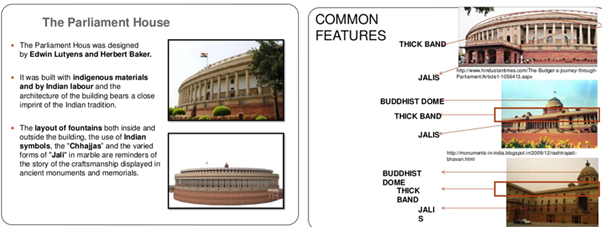
- This would mean the construction of a new building.
- It would incorporate three chambers: the Council of States, the Chamber of Princes, and the Assembly.
- In retrospect, the capital was shifted from Calcutta to Delhi, under King George V in 1911.
- It has borne witness to not just endless debates on sovereignty, federalism, nationalism and independence.
- At the coronation of George V as Emperor of India on December 12, 1911, the monarch announced, “We have decided upon the transfer of the seat of the Government of India from Calcutta to the ancient Capital of Delhi.”
- The said two architects would then build the Parliament House, Rashtrapati Bhawan, North and South Blocks, Rajpath, India Gate, the National Archives building and the princes’ houses around India Gate.
- The construction of the building took six years.
- The opening ceremony was performed on 18 January 1927 by the viceroy and governor-general of India, Lord Irwin.
- From 1927 to 1947, it was the seat of the Imperial Legislative Council.
- Its edifice has been shaken by protests, such as the bombs thrown by Bhagat Singh and Batukeshwar Dutt in 1929.
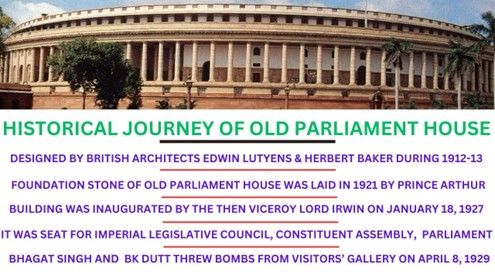
- That was the first time that the revolution entered the halls of Parliament.
- On the eve of India’s independence in 1947 as the clock edged towards midnight, Jawaharlal Nehru stood before the Constituent Assembly, in the packed Central Hall.
- He made his famous speech about India’s tryst with destiny.
- In that speech “A moment comes, which comes but rarely in history when we step out from the old to new, when an age ends, and when the soul of a nation, long suppressed, finds utterance”.
- It is reflecting the nation’s aspirations and a bid to embark on a new journey as the nearly two-centuries-long colonial rule came to an end.
- The Indian Constitution was framed in the Central Hall.
- The Central Hall was originally used in the library of the erstwhile Central Legislative Assembly and the Council of States.
- In 1946, it was converted and refurbished into the Constituent Assembly Hall.
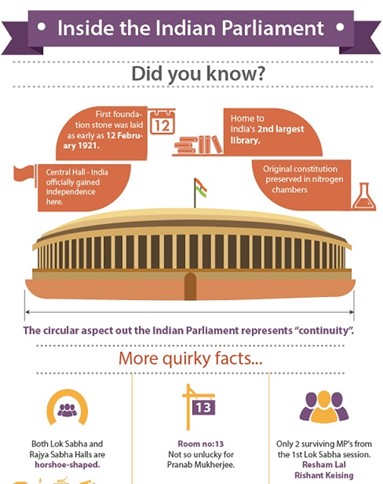
Foundation
- The foundation stone was laid on February 12, 1921, by the Duke of Connaught.
- It took 6 years to complete and the whole project cost around Rs 83 lakh.
- It was originally called the Council House and housed the Imperial Legislative Council, the legislature of British India.
- If one stands at Vijay Chowk at the centre of Kartavya Path, one end of the road leads to India Gate and the other end seems to be going towards Rashtrapati Bhawan.
Inauguration
- On January 18, 1927, Sir Bhupendra Nath Mitra, a member of the Governor-General’s Executive Council and in charge of the Department of Industries and Labour, invited Viceroy Lord Irwin to inaugurate the building.
- The building was inaugurated on January 18, 1927, by Lord Irwin, the Viceroy of India at the time.
- It had initially housed the Imperial Legislative Council.
- The Constituent Assembly of India took control after independence.
- It became the Parliament of India in 1950.
- Two floors were added to the structure in 1956 due to a demand for more space.
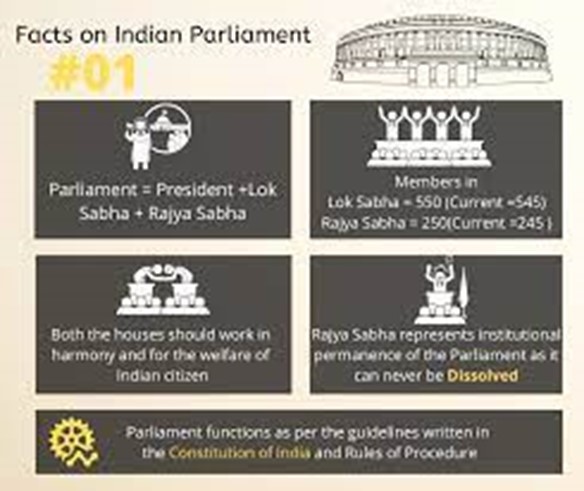
Former Home of the Supreme Court
- The Chamber of Princes in the Parliament Building was also used by the Federal Court of India before independence.
- Afterwards, it served as the Supreme Court’s location for over ten years before the court moved to its own building.
Architectural Aspects
- The building is renowned for its architectural blend of Western and Indian styles.
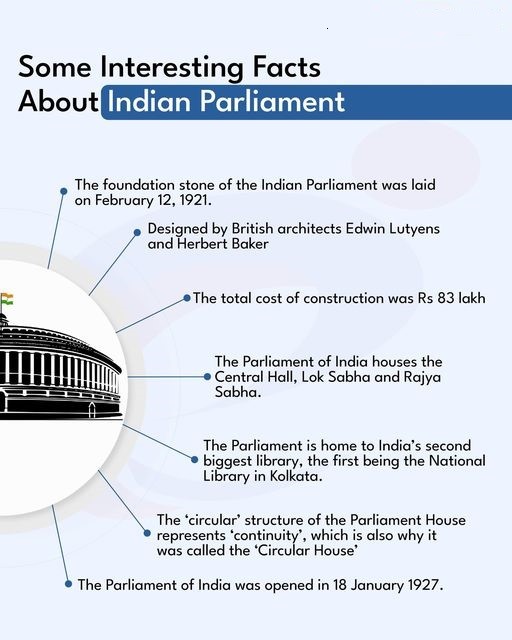
- It incorporates classical Western elements.
- It also features Indian architectural motifs, such as the use of columns and domes.
- It was inspired by the Ekattarso Mahadeva Temple (Chausath Yogini Temple) in Madhya Pradesh.
- The perimeter of the building is circular, with 144 columns on the outside.
- The whole circumference of the Parliament is 1/3rd of a mile (536.33 m).
- Both Lok Sabha and Rajya Sabha halls are horseshoe-shaped.
- The old Parliament was able to accommodate 543 MPs in the Lok Sabha.
- The Rajya Sabha of the Parliament House have a 245-seating capacity.
- The building is surrounded by large gardens and the perimeter is fenced off by sandstone railings (jali).
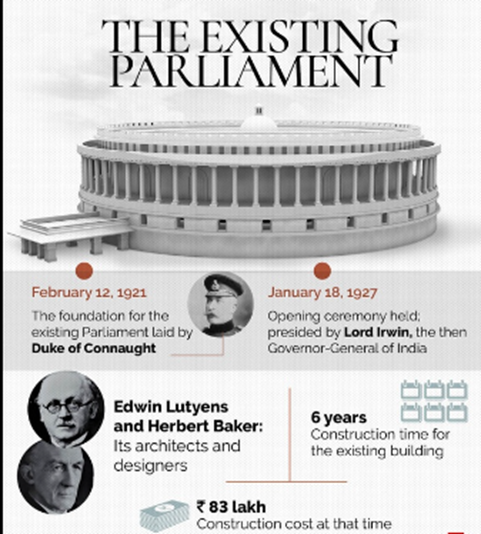
Importance of the Central Hall
- The official transfer of power from UK to India took place in the Central Hall of the Parliament on 14-15th August (midnight) in 1947.
- The Parliament library is the second largest in India. (The National Library in Kolkata is the largest)
- The Parliament Museum, opened in 2006, stands next to the Parliament House, in the building of the Parliamentary Library.
- It was temporarily used as a courtroom by the Supreme Court after Independence till a separate building was assigned to it.
- Both the English and Hindi versions of the Constitution of India originally calligraphed by the members of the Constituent Assembly have been preserved in nitrogen-filled chambers within the library.
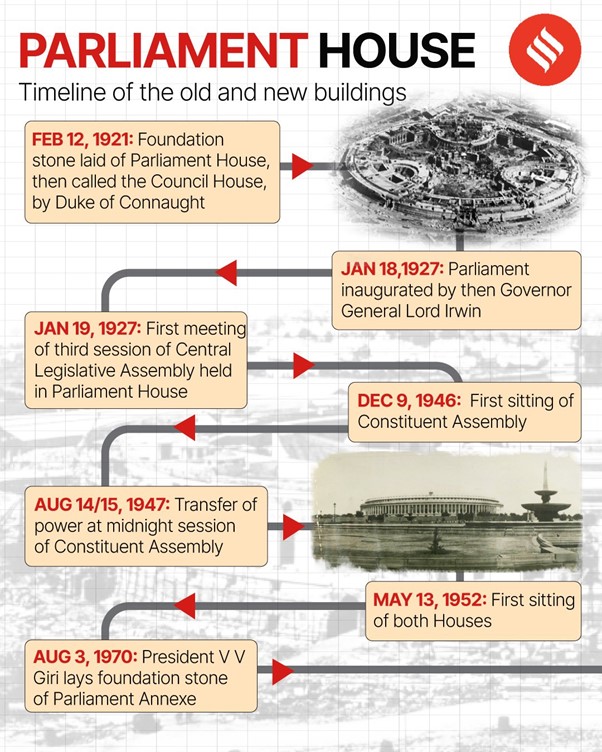
Historical Significance
- The renaming of the old Parliament building holds historical significance, highlighting its role in the formation of the Indian Constitution.
-
Prime Minister Narendra Modi’s a Central Hall speech prompted, emphasizing the building’s importance in India’s democratic journey.
Contributions to Drafting the Constitution
- The old Parliament building was served as the venue for the Constituent Assembly’s sessions from December 9, 1946, to January 24, 1950.
- During the above said period the Indian Constitution was drafted.

Relocation of Joint Sessions
- Joint sessions will now be held in the Lok Sabha chamber within the new Parliament building.
- This relocation signifies a shift in the venue for interactions among MPs, leaders, and the press during such sessions.
- It reflects modernization and may have procedural implications for parliamentary proceedings.
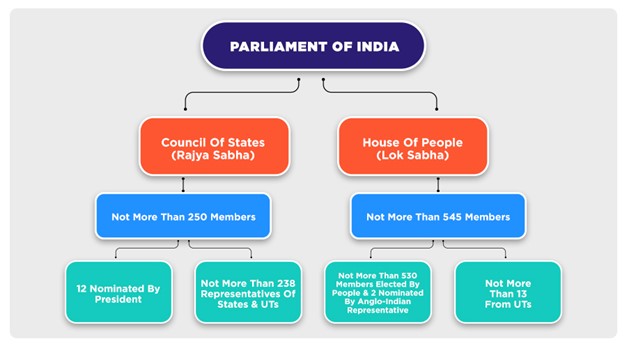
Fostering Informal Interactions
- The old Parliament building was a hub for informal interactions among MPs, leaders, and the press.
- With the move to the new complex, these informal engagements will take place in the Lok Sabha chamber.
- The Parliament House has witnessed India’s history for much more than the 75 years of our independence.
- The building will not be demolished and will be converted into a ‘Museum of Democracy’ after the new Parliament House becomes operational.
- The old parliament building will be called "Samvidhan Sadan (Constitution House)."
- The Prime Minister Narendra Modi announced on September 19 in his last speech from the old building.
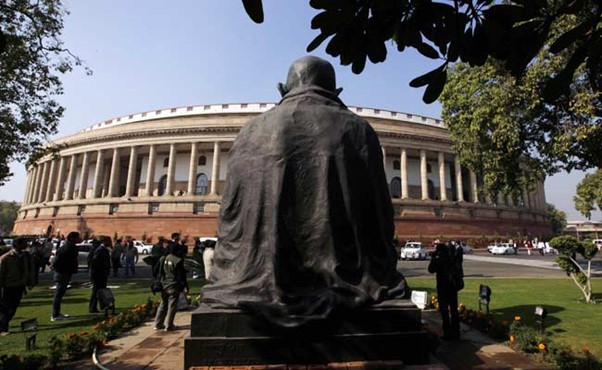
-------------------------------------
Leave a Reply
Your Comment is awaiting moderation.



